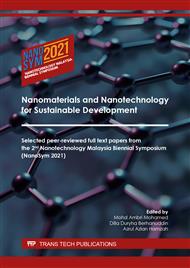[1]
P. K. Chu, J. Chen, L. Wang, and N. Huang, Plasma-surface modification of biomaterials,, Mater. Sci. Eng. R Rep., vol. 36, no. 5-6, pp.143-206, (2002).
Google Scholar
[2]
K. Tsougeni, P. S. Petrou, A. Tserepi, S. E. Kakabakos, and E. Gogolides, Nano-texturing of poly (methyl methacrylate) polymer using plasma processes and applications in wetting control and protein adsorption,, Microelectron. Eng., vol. 86, no. 4-6, pp.1424-1427, (2009).
DOI: 10.1016/j.mee.2008.11.082
Google Scholar
[3]
E. Delamarche, A. Bernard, H. Schmid, A. Bietsch, B. Michel, and H. Biebuyck, Microfluidic networks for chemical patterning of substrates: design and application to bioassays,, J. Am. Chem. Soc., vol. 120, no. 3, pp.500-508, (1998).
DOI: 10.1021/ja973071f
Google Scholar
[4]
K. N. Pandiyaraj, V. Selvarajan, R. Deshmukh, and C. Gao, Modification of surface properties of polypropylene (PP) film using DC glow discharge air plasma,, Appl. Surf. Sci., vol. 255, no. 7, pp.3965-3971, (2009).
DOI: 10.1016/j.apsusc.2008.10.090
Google Scholar
[5]
S. Samukawa et al., The 2012 plasma roadmap,, J. Phys. D Appl. Phys., vol. 45, no. 25, p.253001, (2012).
Google Scholar
[6]
M. Ito, J. S. Oh, T. Ohta, M. Shiratani, and M. Hori, Current status and future prospects of agricultural applications using atmospheric‐pressure plasma technologies,, Plasma Process. Polym., vol. 15, no. 2, p.1700073, (2018).
DOI: 10.1002/ppap.201700073
Google Scholar
[7]
V. Štěpánová et al., Atmospheric pressure plasma treatment of agricultural seeds of cucumber (Cucumis sativus L.) and pepper (Capsicum annuum L.) with effect on reduction of diseases and germination improvement,, Plasma Process. Polym., vol. 15, no. 2, p.1700076, (2018).
DOI: 10.1002/ppap.201700076
Google Scholar
[8]
E. Bormashenko, R. Grynyov, Y. Bormashenko, and E. Drori, Cold radiofrequency plasma treatment modifies wettability and germination speed of plant seeds,, Sci. Rep., vol. 2, no. 1, pp.1-8, (2012).
DOI: 10.1038/srep00741
Google Scholar
[9]
J. Tong, R. He, X. Zhang, R. Zhan, W. Chen, and S. Yang, Effects of Atmospheric Pressure Air Plasma Pretreatment on the Seed Germination and Early Growth ofAndrographis paniculata,, Plasma Sci. Technol., vol. 16, no. 3, pp.260-266, (2014).
DOI: 10.1088/1009-0630/16/3/16
Google Scholar
[10]
M. Dhayal, S.-Y. Lee, and S.-U. Park, Using low-pressure plasma for Carthamus tinctorium L. seed surface modification,, Vacuum, vol. 80, no. 5, pp.499-506, (2006).
DOI: 10.1016/j.vacuum.2005.06.008
Google Scholar
[11]
N. Ahmed, A. Masood, K. S. Siow, M. Wee, R. Auliya, and W. Ho, Effect of H2O-Based Low-Pressure Plasma (LPP) Treatment on the Germination of Bambara Groundnut Seeds,, Agronomy, vol. 11, no. 2, p.338, (2021).
DOI: 10.3390/agronomy11020338
Google Scholar
[12]
T. Homola, V. Prukner, A. Artemenko, J. Hanuš, O. Kylián, and M. Šimek, Direct treatment of pepper (Capsicum annuum L.) and melon (Cucumis melo) seeds by amplitude-modulated dielectric barrier discharge in air,, J. Appl. Phys., vol. 129, no. 19, p.193303, (2021).
DOI: 10.1063/5.0039165
Google Scholar
[13]
K. S. Siow, Low pressure plasma modifications for the generation of hydrophobic coatings for biomaterials applications,, Plasma Process. Polym., vol. 15, no. 9, p.1800059, (2018).
DOI: 10.1002/ppap.201800059
Google Scholar
[14]
K. S. Siow, L. Britcher, S. Kumar, and H. J. Griesser, Plasma methods for the generation of chemically reactive surfaces for biomolecule immobilization and cell colonization‐a review,, Plasma Process. Polym., vol. 3, no. 6‐7, pp.392-418, (2006).
DOI: 10.1002/ppap.200600021
Google Scholar
[15]
K. S. Siow, S. Kumar, and H. J. Griesser, Low‐Pressure Plasma Methods for Generating Non‐Reactive Hydrophilic and Hydrogel‐Like Bio‐Interface Coatings–A Review,, Plasma Process. Polym., vol. 12, no. 1, pp.8-24, (2015).
DOI: 10.1002/ppap.201400116
Google Scholar
[16]
N. Ahmed et al., Effects of oxygen (O2) plasma treatment in promoting the germination and growth of chili.,, Plasma Chem. Plasma Process., vol. (accepted for publication), (2021).
DOI: 10.1007/s11090-021-10206-2
Google Scholar
[17]
T. F. Chen, K. S. Siow, P. Y. Ng, and B. Y. Majlis, Enhancing the biocompatibility of the polyurethane methacrylate and off-stoichiometry thiol-ene polymers by argon and nitrogen plasma treatment,, Mater. Sci. Eng. C, vol. 79, pp.613-621, Oct 1 (2017).
DOI: 10.1016/j.msec.2017.05.091
Google Scholar
[18]
T. F. Chen, K. S. Siow, P. Y. Ng, M. H. Nai, C. T. Lim, and B. Yeop Majlis, Ageing properties of polyurethane methacrylate and off-stoichiometry thiol-ene polymers after nitrogen and argon plasma treatment,, J. Appl. Polym. Sci., vol. 133, no. 42, p.44107, (2016).
DOI: 10.1002/app.44107
Google Scholar
[19]
K. S. Siow, S. Kumar, and H. J. Griesser, Low-Pressure Plasma Methods for Generating Non-Reactive Hydrophilic and Hydrogel-Like Bio-Interface Coatings - A Review,, Plasma Process. Polym., vol. 12, no. 1, pp.8-24, (2015).
DOI: 10.1002/ppap.201400116
Google Scholar
[20]
S. Guimond, I. Radu, G. Czeremuszkin, D. J. Carlsson, and M. R. Wertheimer, Biaxially oriented polypropylene (BOPP) surface modification by nitrogen atmospheric pressure glow discharge (APGD) and by air corona,, Plasmas and Polymers, vol. 7, no. 1, pp.71-88, (2002).
DOI: 10.1023/a:1015274118642
Google Scholar
[21]
S. Mirabedini, H. Arabi, A. Salem, and S. Asiaban, Effect of low-pressure O2 and Ar plasma treatments on the wettability and morphology of biaxial-oriented polypropylene (BOPP) film,, Prog. Org. Coat., vol. 60, no. 2, pp.105-111, (2007).
DOI: 10.1016/j.porgcoat.2007.07.007
Google Scholar
[22]
K. Chaffin, C. Taylor, and T. Grailer, Bonding strategies and adhesives for joining medical device components,, in Joining and Assembly of Medical Materials and Devices. USA: Elsevier, 2013, pp.370-404.
DOI: 10.1533/9780857096425.3.370
Google Scholar
[23]
A. Vesel and M. Mozetic, Surface modification and ageing of PMMA polymer by oxygen plasma treatment,, Vacuum, vol. 86, no. 6, pp.634-637, (2012).
DOI: 10.1016/j.vacuum.2011.07.005
Google Scholar
[24]
T. R. Gengenbach, Z. R. Vasic, R. C. Chatelier, and H. J. Griesser, A multi‐technique study of the spontaneous oxidation of N‐hexane plasma polymers,, J. Polym. Sci., Part A: Polym. Chem., vol. 32, no. 8, pp.1399-1414, (1994).
DOI: 10.1002/pola.1994.080320801
Google Scholar


